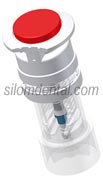 |
|


SLActive
The next generation in implant technology
Question - Answers
language |
l |
THAI |
|
|
Is SLActive supported by scientific data gained from clinical studies?
Has the improvement of the Gold Standard SLA® with SLActive been proven in clinical studies?
Is SLActive only active for 15 minutes after removal from the vial?
Can SLA be made hydrophilic and active by immersion in Sodium Chloride?
Why is the healing time important if immediate loading is also possible with standard surfaces?
Is early loading possible for all implant types and indications after 3-4 weeks?
|
|
Is SLActive supported by scientific data gained from clinical studies?
|
|
|
Has the improvement of the Gold Standard SLA with SLActive been proven in clinical studies? |
|
|
Is SLActive only active for 15 minutes after removal from the vial? |
|
|
Can SLA be made hydrophilic and active by immersion in Sodium Chloride? |
|
|
Why is the healing time important if immediate loading is also possible with standard surfaces? |
|
|
Is early loading possible for all implant types and indications after 3-4 weeks? |
HOME
l SERVICE
l DENTISTS
l TECHNOLOGY
l FACILITIES
l ABOUT US
l SITE MAP
PROMOTION
l PRICE&DURATION
l CONSULTATION
l FAQ
l LINKS
l MAP
l TESTIMONIALS
l OUR LAB
l RESOURCES
DENTAL BRACES
l LASER TEETH WHITENING
l IMPLANT DENTISTRY
l ENDODONTICS
l OPERATIVE DENTISTRY
l SEDATION DENTISTRY
COSMETIC DENTISTRY
l PROSTHODONTICS
l PERIODONTICS
l ORAL SURGERY
l PAEDODONTICS
l GP & ORAL EXAM
l OCCLUSION
DENTAL OFFICE
l DENTAL CLINIC
l COSMETIC DENTISTRY
l COSMETIC DENTIST
l TEETH BLEACHING
l TOOTH WHITENING
DENTAL CROWNS
l DENTAL IMPLANTS
l DENTAL TREATMENT
l DENTAL IMPLANT
............................................................................................................................. Copyright© 2004 SILOM DENTAL BUILDING. All Rights Reserved.
Local Call : 0 2636 9092-5, International Call : (+) 66 2636 9091, (+) 66 2636 9097
e-mail :silomdental@silomdental.com
Dental Implant, Dental Implants, Implant, Dental Implant Bangkok, Dental Implants Thailand, Implant Dental Center, Implant Bangkok Thailand



